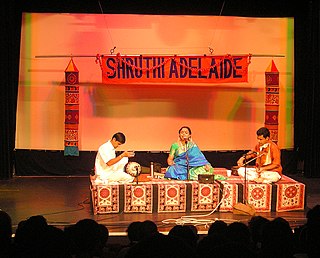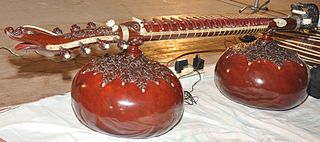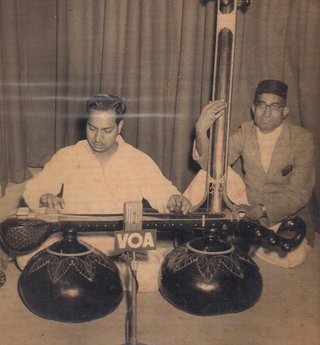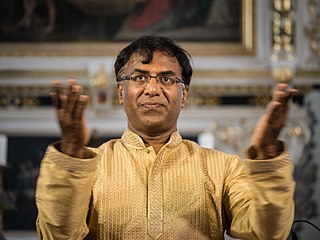
The shruti or śruti is the smallest interval of pitch that the human ear can detect and a singer or musical instrument can produce. The concept is found in ancient and medieval Sanskrit texts such as the Natya Shastra, the Dattilam, the Brihaddeshi, and the Sangita Ratnakara. Chandogya Upanishad speaks of the division of the octave in 22 parts.

The Rudra veena —also called Bīn in North India—is a large plucked string instrument used in Hindustani Music, especially dhrupad. It is one of the major types of veena played in Indian classical music, notable for its deep bass resonance.

The Sangita-Ratnakara, संगीतरत्नाकर,, literally "Ocean of Music and Dance", is one of the most important musicological texts from India. Composed by Śārṅgadeva (शार्ङ्गदेव) in Sanskrit during the 13th century, both Carnatic music and Hindustani music traditions of Indian classical music regard it as a definitive text. The author was a part of the court of King Simhana of the Yādava dynasty whose capital was Devagiri, Maharashtra.

The vichitra veena is a stick zither, a plucked string instrument used in Hindustani music. Similar to the Carnatic gottuvadhyam it has no frets and is played with a slide.

The Sarasvatī vīṇa is an ancient Indian plucked veena. It is named after the Hindu goddess Saraswati, who is usually depicted holding or playing the instrument. Also known as raghunatha veena, it is used mostly in Carnatic Indian classical music. There are several variations of the veena, which in its South Indian form is a member of the lute family. One who plays the veena is referred to as a vaiṇika.

Narasimhan Ravikiran is an Indian slide instrumentalist, vocalist, composer, and orator, who created the concept of melharmony. He is the son of gottuvadhyam player Chitravina Narasimhan and the grandson of Narayan Iyengar, who was also a Carnatic musician.
Sakharam Rao was an Indian musician credited with having re-introduced the south Indian chitravina or gottuvadyam to the concert scene.
Śārṅgadeva (1175–1247), also spelled Sharngadeva or Sarnga Deva, was a 13th-century Indian musicologist who authored Sangita Ratnakara – a Sanskrit text on music and drama. It is considered to be the authoritative treatise on Indian classical music by both the Hindustani and Carnatic music traditions.
Within Indian classical music for Shruti, Sarana Chatushtai is an experiment. The purpose is to obtain the correct physical configuration of Śruti swara arrangement to Shadja Grama Notes on a veena instrument. The experiment is described in Abhinavabharati, a commentary to Natya Shastra, as an explanation after verse 28.26 of Natyashastra. The 22 Srutis are the only notes which can be useful for music in an “octave”, in this view. The sections below describe the experiment.
Avinash Balkrishna Patwardhan born 30 August 1953 in Nagpur, Maharshatra (India) is a civil engineer from Govt College of Engineering, Amravati (GCoEA) in 1975 and a law graduate who has profound knowledge and interest in Indian classical music. He is the first person in recent centuries to unveil and demonstrate the Sarana Chatushtai as originally suggested by Bharata Muni in the Bharata Natya Shastra which is the only way to obtain 22 srutis on a musical instrument. He started his career as an engineer with the state government of Maharashtra. Later he went into teaching civil engineering and eventually joined social work. He was a part of the Knit India movement (1985–1988) and Narmada Bachao Andolan (1998-1993) with late Baba Amte. He also worked with Dr. Vikas Amte for Earthquake Relief at Killari, Maharashtra (1993–1994). He started his research on Indian classical music in the 1990s which led to his work on the Sarana Chatushtai and later he also evolved a methodology to develop perfectly tuned flutes.

Music in ancient India, can be reproduced from written works dating to the Indian classical period, such as the Nātya Shastra, and through surviving examples of liturgical music such as the hymns of the Samaveda. Musical instruments dating to the prehistoric period have been recovered from archaeological excavations.
Thanjavur Muktha, also spelt Mukta and often referred as Mukthamma, (1914–2007) was one of the foremost representatives of the Veena Dhanammal school of Carnatic Music. She, along with her elder sister T. Brinda, formed one of the first women duo singers in Carnatic Music.

Odissi music is a genre of classical music in India, originated from the eastern state of Odisha. The traditional ritual music for the service of Lord Jagannatha, Odissi music has a history spanning over two thousand years, authentic sangita-shastras or treatises, unique Ragas & Talas and a distinctive style of rendition.
The yazh is a harp used in ancient Tamil music. It was strung with gut strings that ran from a curved ebony neck to a boat or trough-shaped resonator, the opening of which was a covered with skin for a soundboard. At the resonator the strings were attached to a string-bar or tuning bar with holes for strings that laid beneath of the soundboard and protruded through. The neck may also have been covered in hide.

The veena, also spelled vina, is any of various chordophone instruments from the Indian subcontinent. Ancient musical instruments evolved into many variations, such as lutes, zithers and arched harps. The many regional designs have different names such as the Rudra veena, the Saraswati veena, the Vichitra veena and others.
Sangita, also spelled Samgita or Sangeeta, refers to "music and associated performance arts" in the Indian traditions. According to Guy Beck, the root "saṃ-" implies "combining, coming together, convergent wholesome blending, unison" in the context of musical arts. Sangita connotes any form of singing with music, harmonious recitation or chorus singing in particular. In some medieval era literary genre such as the Puranas and poetic texts such as Kathasaritsagar, a related term Sangita-shastra and Sangita-vidya mean the "art, science or knowledge of singing and dancing with music". According to Alison Arnold and Bruno Nettl, the modern term music fails to capture the historic sense of "Sanskrit sangita and Greek mousike". In the Indian tradition, the term sangita includes melodious singing, rhythmic dancing, instrumental music, classical, provincial, ritual chanting and incidental forms of music-related performance arts.

Karaikudi Sambasiva Iyer Subramanian is a veena player in the Karaikudi Veena Tradition. He is the grandson of Karaikudi Subbarama Iyer and adoptive son of Karaikudi Sambasiva Iyer.

The kinnari vina is a historical veena, a tube zither with gourds attached to act as resonators and frets. It was played in India into the late 19th century and was documented by two European artists. The instrument dates back into medieval times and possibly as far back as 500 C.E. It is closely related to the Alapini Vina and Eka-tantri Vina, the instruments having coexisted in medieval times.

The eka-tantrī vīṇā was a medieval tube-zither veena in India, with a single string and one or more gourd resonators. The instrument became prominent in Indian music in about the 10th century C.E. as instruments of court music. Alongside the alapini vina and kinnari vina it replaced the harp-style veenas and lute-style veenas in sculpture. It was possibly a forerunner of the rudra vina. It shares its name with the modern single-string drone lute, the ektara.

The ālāpiṇī vīṇā was a medieval stick-zither veena in India, with a single string and a gourd resonator. Later forms added more strings. The instruments became prominent in Indian music after 500 C.E. as instruments of court music. Alongside the eka-tantri vina and kinnari vina it replaced the harp-style veenas and lute-style veenas. The instruments were used in Southeast Asia, both mainland and island nations, and were recorded in sculpture and relief sculpture.













